Comprehensive Analysis of Reebok's Supply Chain Management
VerifiedAdded on 2020/05/04
|14
|2917
|88
Report
AI Summary
This report provides a comprehensive analysis of Reebok's supply chain management. It begins with an introduction to supply chain concepts and a brief overview of Reebok's company background. The report then delves into the key flows within Reebok's supply chain, including product flow, information flow, cash flow, and return flow, offering recommendations for improvement in each area. The analysis further examines Reebok's make process, including production planning and inventory requirement planning. The report also assesses Reebok's supply chain forecasting techniques, specifically demand planning and forecasting, and provides recommendations for enhancing forecasting accuracy. The report concludes by summarizing the key findings and emphasizing the importance of an efficient supply chain for Reebok's continued success. The report highlights the importance of effective product and information flow, efficient production planning, and accurate demand forecasting for Reebok. The report also provides some recommendations for improving the process. The report is an excellent resource for students studying supply chain management and provides insights into the practical application of supply chain principles within a real-world company.
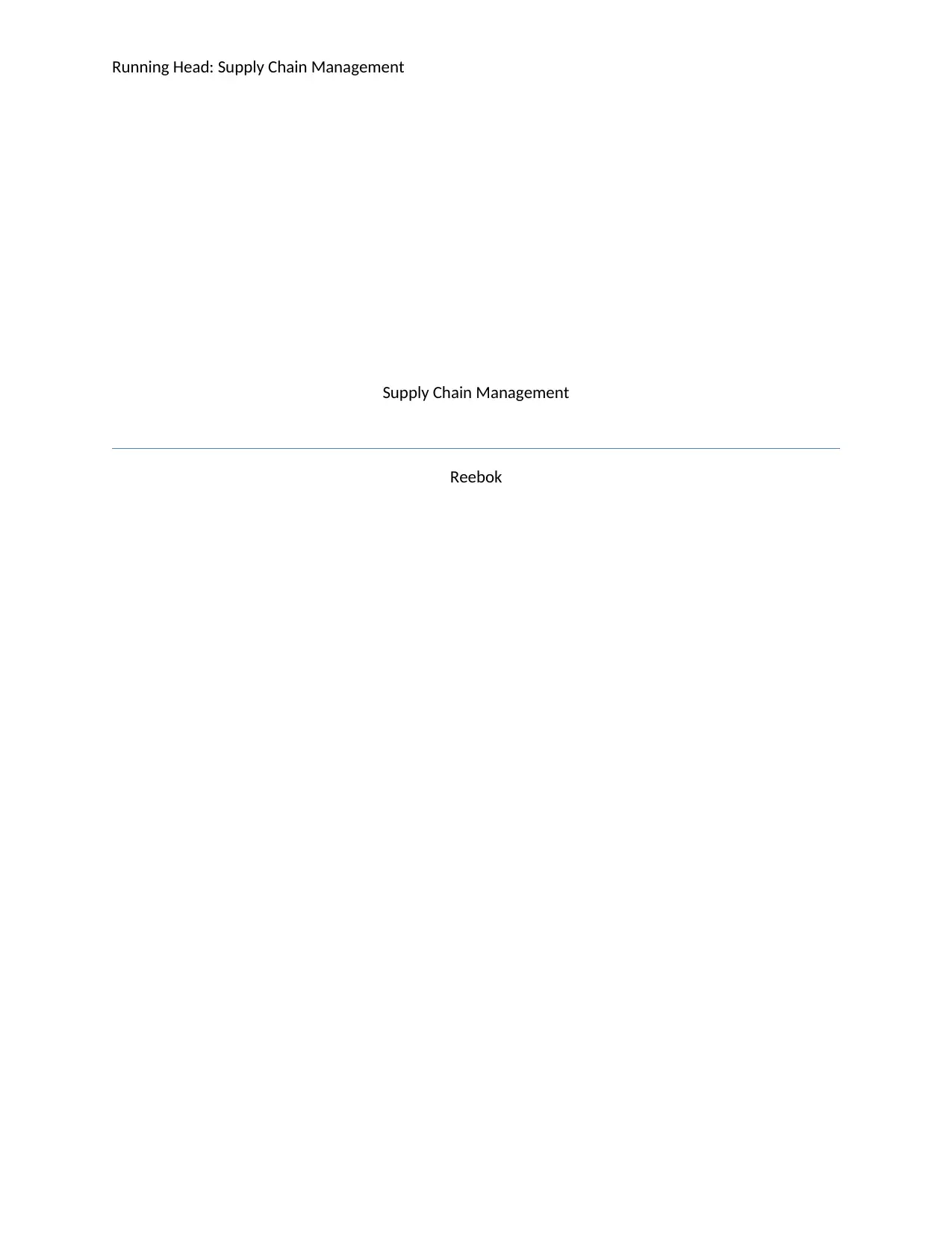
Running Head: Supply Chain Management
Supply Chain Management
Reebok
Supply Chain Management
Reebok
Paraphrase This Document
Need a fresh take? Get an instant paraphrase of this document with our AI Paraphraser
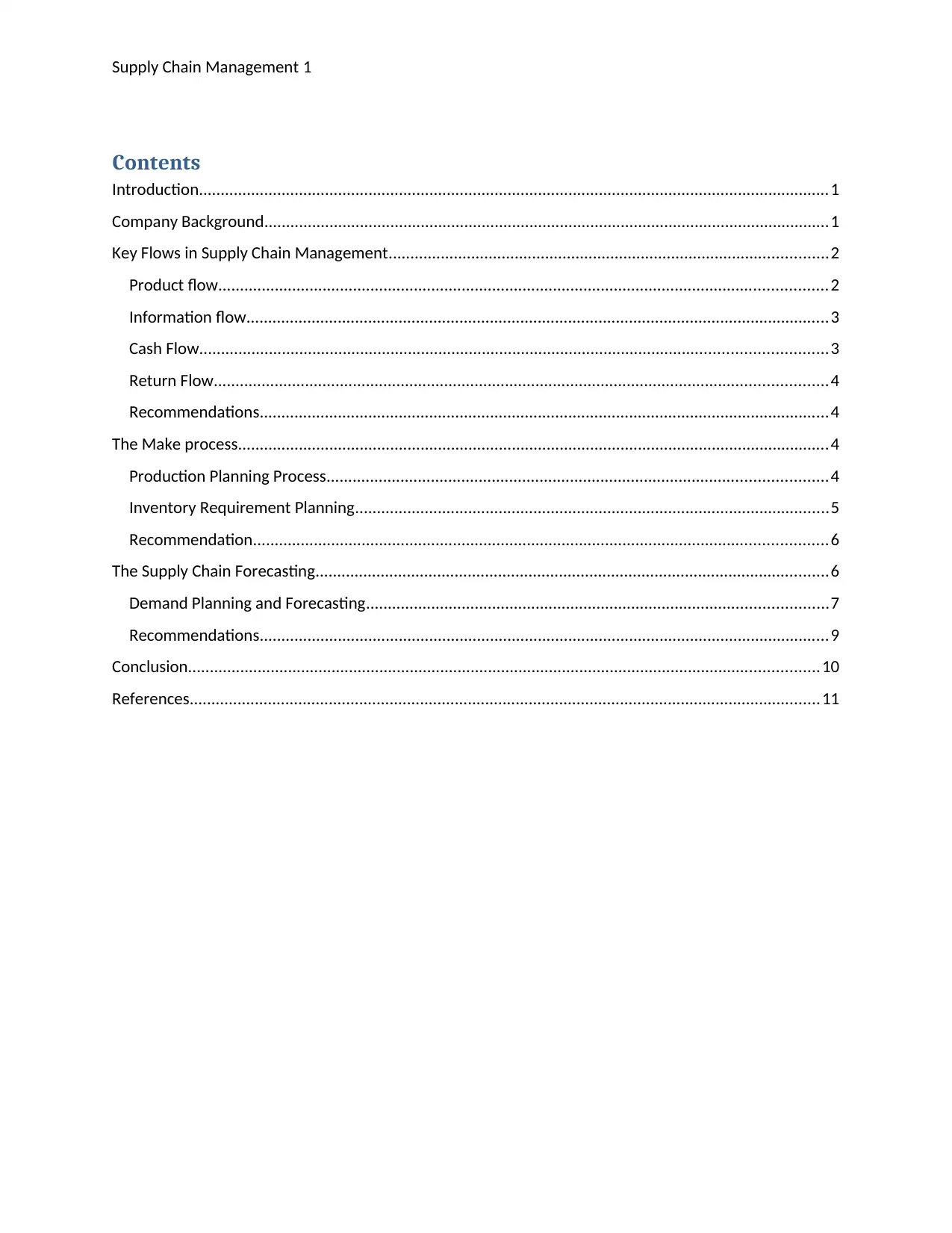
Supply Chain Management 1
Contents
Introduction.................................................................................................................................................1
Company Background..................................................................................................................................1
Key Flows in Supply Chain Management.....................................................................................................2
Product flow............................................................................................................................................2
Information flow......................................................................................................................................3
Cash Flow................................................................................................................................................3
Return Flow.............................................................................................................................................4
Recommendations...................................................................................................................................4
The Make process........................................................................................................................................4
Production Planning Process...................................................................................................................4
Inventory Requirement Planning.............................................................................................................5
Recommendation....................................................................................................................................6
The Supply Chain Forecasting......................................................................................................................6
Demand Planning and Forecasting..........................................................................................................7
Recommendations...................................................................................................................................9
Conclusion.................................................................................................................................................10
References.................................................................................................................................................11
Contents
Introduction.................................................................................................................................................1
Company Background..................................................................................................................................1
Key Flows in Supply Chain Management.....................................................................................................2
Product flow............................................................................................................................................2
Information flow......................................................................................................................................3
Cash Flow................................................................................................................................................3
Return Flow.............................................................................................................................................4
Recommendations...................................................................................................................................4
The Make process........................................................................................................................................4
Production Planning Process...................................................................................................................4
Inventory Requirement Planning.............................................................................................................5
Recommendation....................................................................................................................................6
The Supply Chain Forecasting......................................................................................................................6
Demand Planning and Forecasting..........................................................................................................7
Recommendations...................................................................................................................................9
Conclusion.................................................................................................................................................10
References.................................................................................................................................................11
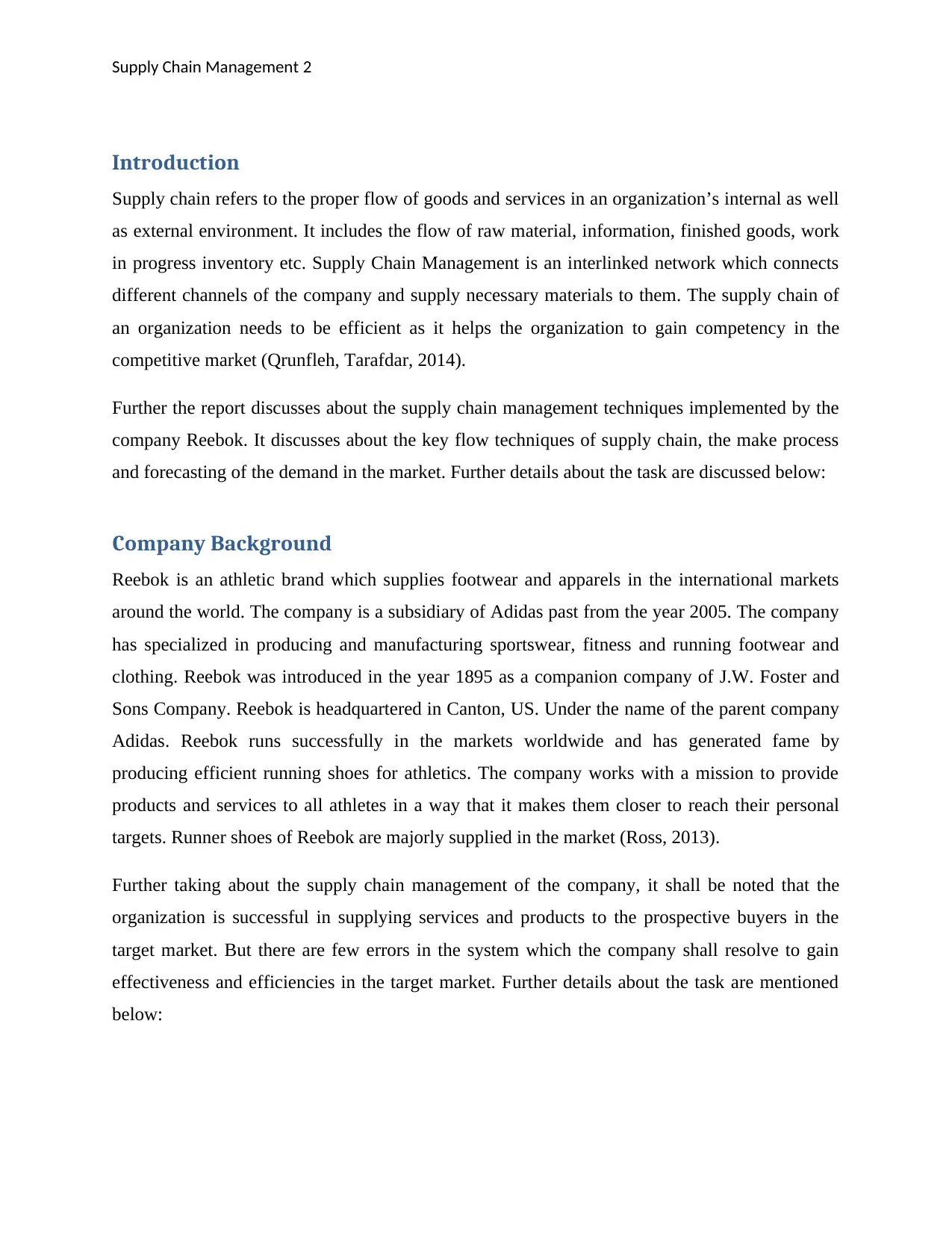
Supply Chain Management 2
Introduction
Supply chain refers to the proper flow of goods and services in an organization’s internal as well
as external environment. It includes the flow of raw material, information, finished goods, work
in progress inventory etc. Supply Chain Management is an interlinked network which connects
different channels of the company and supply necessary materials to them. The supply chain of
an organization needs to be efficient as it helps the organization to gain competency in the
competitive market (Qrunfleh, Tarafdar, 2014).
Further the report discusses about the supply chain management techniques implemented by the
company Reebok. It discusses about the key flow techniques of supply chain, the make process
and forecasting of the demand in the market. Further details about the task are discussed below:
Company Background
Reebok is an athletic brand which supplies footwear and apparels in the international markets
around the world. The company is a subsidiary of Adidas past from the year 2005. The company
has specialized in producing and manufacturing sportswear, fitness and running footwear and
clothing. Reebok was introduced in the year 1895 as a companion company of J.W. Foster and
Sons Company. Reebok is headquartered in Canton, US. Under the name of the parent company
Adidas. Reebok runs successfully in the markets worldwide and has generated fame by
producing efficient running shoes for athletics. The company works with a mission to provide
products and services to all athletes in a way that it makes them closer to reach their personal
targets. Runner shoes of Reebok are majorly supplied in the market (Ross, 2013).
Further taking about the supply chain management of the company, it shall be noted that the
organization is successful in supplying services and products to the prospective buyers in the
target market. But there are few errors in the system which the company shall resolve to gain
effectiveness and efficiencies in the target market. Further details about the task are mentioned
below:
Introduction
Supply chain refers to the proper flow of goods and services in an organization’s internal as well
as external environment. It includes the flow of raw material, information, finished goods, work
in progress inventory etc. Supply Chain Management is an interlinked network which connects
different channels of the company and supply necessary materials to them. The supply chain of
an organization needs to be efficient as it helps the organization to gain competency in the
competitive market (Qrunfleh, Tarafdar, 2014).
Further the report discusses about the supply chain management techniques implemented by the
company Reebok. It discusses about the key flow techniques of supply chain, the make process
and forecasting of the demand in the market. Further details about the task are discussed below:
Company Background
Reebok is an athletic brand which supplies footwear and apparels in the international markets
around the world. The company is a subsidiary of Adidas past from the year 2005. The company
has specialized in producing and manufacturing sportswear, fitness and running footwear and
clothing. Reebok was introduced in the year 1895 as a companion company of J.W. Foster and
Sons Company. Reebok is headquartered in Canton, US. Under the name of the parent company
Adidas. Reebok runs successfully in the markets worldwide and has generated fame by
producing efficient running shoes for athletics. The company works with a mission to provide
products and services to all athletes in a way that it makes them closer to reach their personal
targets. Runner shoes of Reebok are majorly supplied in the market (Ross, 2013).
Further taking about the supply chain management of the company, it shall be noted that the
organization is successful in supplying services and products to the prospective buyers in the
target market. But there are few errors in the system which the company shall resolve to gain
effectiveness and efficiencies in the target market. Further details about the task are mentioned
below:
⊘ This is a preview!⊘
Do you want full access?
Subscribe today to unlock all pages.

Trusted by 1+ million students worldwide

Supply Chain Management 3
Key Flows in Supply Chain Management
Supply Chain management refers to the system which involves all the sources present in the
organization and use them in a way to provide benefit to the organization. It includes rotation of
products, goods, services, inventory etc. from the suppliers to the customers present in the global
market. Further this flow helps the customers to attain the products of the company and gain
better satisfaction (Seuring, 2013). Better the supply chain, better the optimization of resources
in the organization. The key flows of supply chain are discussed below:
Product flow
The process of product flow of Reebok is efficient as well as effective. The product flow also
includes the services like packaging and sample. The product flow process in supply chain refers
to the movement of goods from suppliers to the customers of organization who maybe internal or
external. And it also includes the process of dealing with the needs of customers present in the
environment. In the company Reebok, the management looked for the team members to support
their mission and help the company to expand as well. In order to gain the competitive edge in
the target market, organization needs to increase the level of satisfaction of employees. Thus, the
Key Flows in Supply Chain Management
Supply Chain management refers to the system which involves all the sources present in the
organization and use them in a way to provide benefit to the organization. It includes rotation of
products, goods, services, inventory etc. from the suppliers to the customers present in the global
market. Further this flow helps the customers to attain the products of the company and gain
better satisfaction (Seuring, 2013). Better the supply chain, better the optimization of resources
in the organization. The key flows of supply chain are discussed below:
Product flow
The process of product flow of Reebok is efficient as well as effective. The product flow also
includes the services like packaging and sample. The product flow process in supply chain refers
to the movement of goods from suppliers to the customers of organization who maybe internal or
external. And it also includes the process of dealing with the needs of customers present in the
environment. In the company Reebok, the management looked for the team members to support
their mission and help the company to expand as well. In order to gain the competitive edge in
the target market, organization needs to increase the level of satisfaction of employees. Thus, the
Paraphrase This Document
Need a fresh take? Get an instant paraphrase of this document with our AI Paraphraser
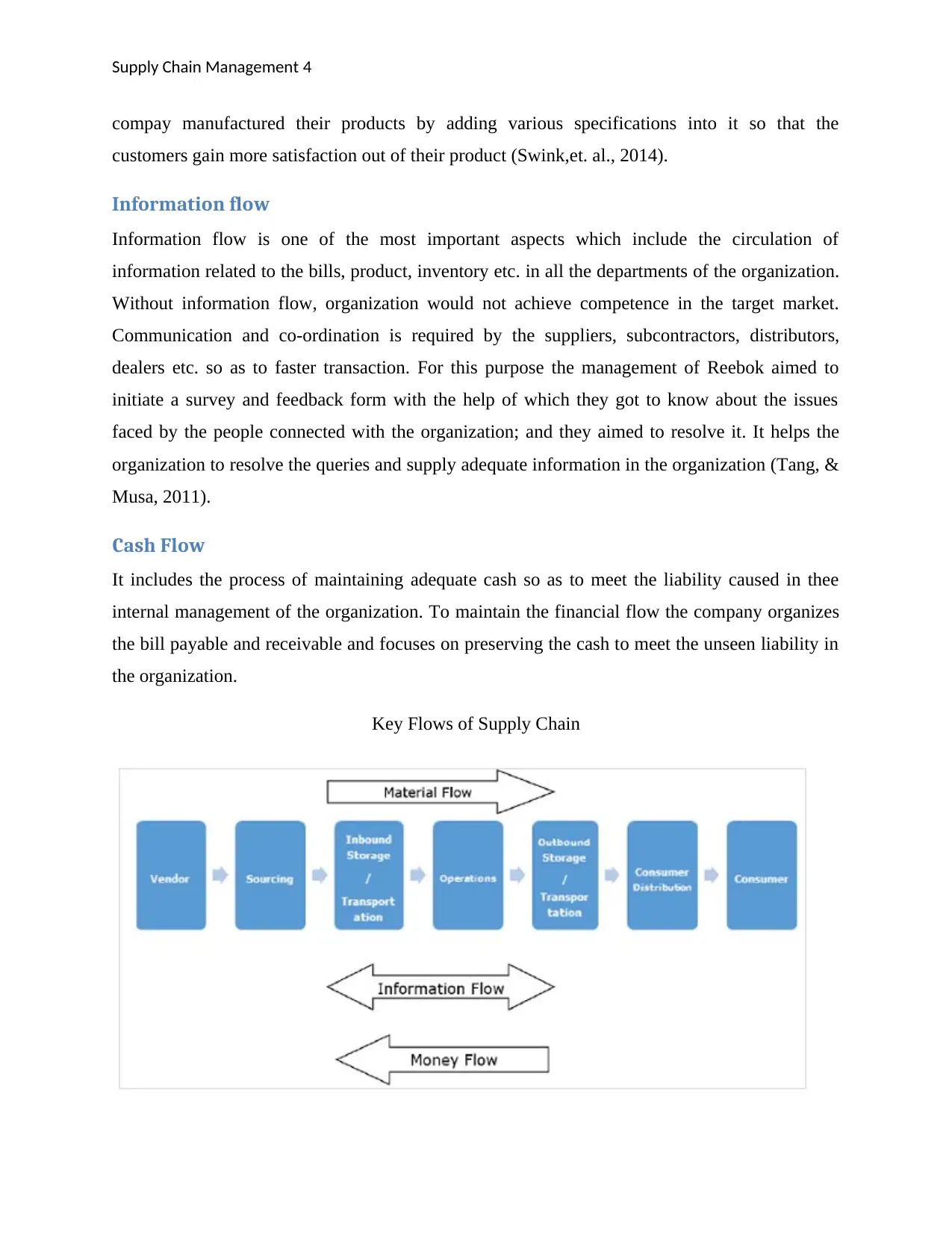
Supply Chain Management 4
compay manufactured their products by adding various specifications into it so that the
customers gain more satisfaction out of their product (Swink,et. al., 2014).
Information flow
Information flow is one of the most important aspects which include the circulation of
information related to the bills, product, inventory etc. in all the departments of the organization.
Without information flow, organization would not achieve competence in the target market.
Communication and co-ordination is required by the suppliers, subcontractors, distributors,
dealers etc. so as to faster transaction. For this purpose the management of Reebok aimed to
initiate a survey and feedback form with the help of which they got to know about the issues
faced by the people connected with the organization; and they aimed to resolve it. It helps the
organization to resolve the queries and supply adequate information in the organization (Tang, &
Musa, 2011).
Cash Flow
It includes the process of maintaining adequate cash so as to meet the liability caused in thee
internal management of the organization. To maintain the financial flow the company organizes
the bill payable and receivable and focuses on preserving the cash to meet the unseen liability in
the organization.
Key Flows of Supply Chain
compay manufactured their products by adding various specifications into it so that the
customers gain more satisfaction out of their product (Swink,et. al., 2014).
Information flow
Information flow is one of the most important aspects which include the circulation of
information related to the bills, product, inventory etc. in all the departments of the organization.
Without information flow, organization would not achieve competence in the target market.
Communication and co-ordination is required by the suppliers, subcontractors, distributors,
dealers etc. so as to faster transaction. For this purpose the management of Reebok aimed to
initiate a survey and feedback form with the help of which they got to know about the issues
faced by the people connected with the organization; and they aimed to resolve it. It helps the
organization to resolve the queries and supply adequate information in the organization (Tang, &
Musa, 2011).
Cash Flow
It includes the process of maintaining adequate cash so as to meet the liability caused in thee
internal management of the organization. To maintain the financial flow the company organizes
the bill payable and receivable and focuses on preserving the cash to meet the unseen liability in
the organization.
Key Flows of Supply Chain
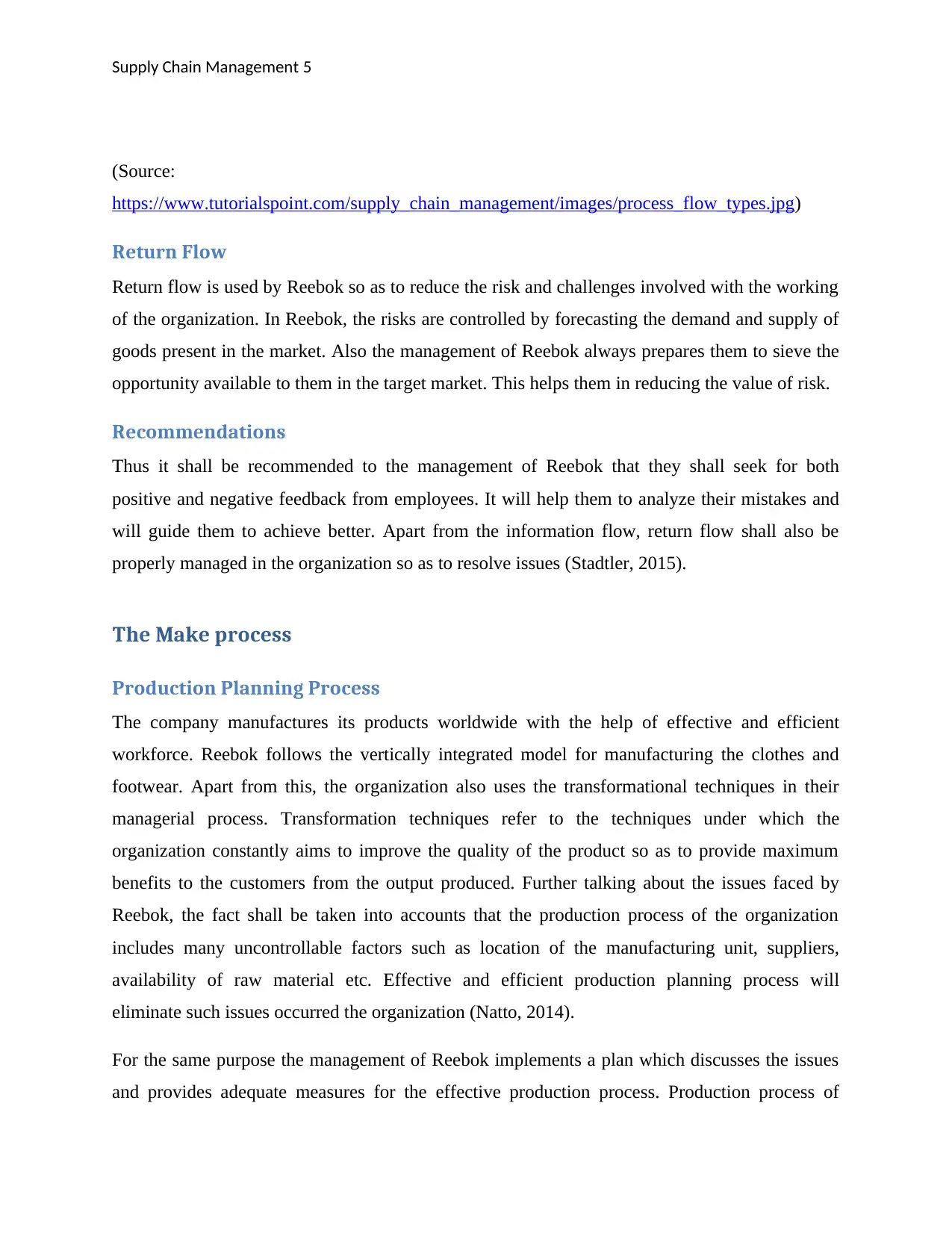
Supply Chain Management 5
(Source:
https://www.tutorialspoint.com/supply_chain_management/images/process_flow_types.jpg)
Return Flow
Return flow is used by Reebok so as to reduce the risk and challenges involved with the working
of the organization. In Reebok, the risks are controlled by forecasting the demand and supply of
goods present in the market. Also the management of Reebok always prepares them to sieve the
opportunity available to them in the target market. This helps them in reducing the value of risk.
Recommendations
Thus it shall be recommended to the management of Reebok that they shall seek for both
positive and negative feedback from employees. It will help them to analyze their mistakes and
will guide them to achieve better. Apart from the information flow, return flow shall also be
properly managed in the organization so as to resolve issues (Stadtler, 2015).
The Make process
Production Planning Process
The company manufactures its products worldwide with the help of effective and efficient
workforce. Reebok follows the vertically integrated model for manufacturing the clothes and
footwear. Apart from this, the organization also uses the transformational techniques in their
managerial process. Transformation techniques refer to the techniques under which the
organization constantly aims to improve the quality of the product so as to provide maximum
benefits to the customers from the output produced. Further talking about the issues faced by
Reebok, the fact shall be taken into accounts that the production process of the organization
includes many uncontrollable factors such as location of the manufacturing unit, suppliers,
availability of raw material etc. Effective and efficient production planning process will
eliminate such issues occurred the organization (Natto, 2014).
For the same purpose the management of Reebok implements a plan which discusses the issues
and provides adequate measures for the effective production process. Production process of
(Source:
https://www.tutorialspoint.com/supply_chain_management/images/process_flow_types.jpg)
Return Flow
Return flow is used by Reebok so as to reduce the risk and challenges involved with the working
of the organization. In Reebok, the risks are controlled by forecasting the demand and supply of
goods present in the market. Also the management of Reebok always prepares them to sieve the
opportunity available to them in the target market. This helps them in reducing the value of risk.
Recommendations
Thus it shall be recommended to the management of Reebok that they shall seek for both
positive and negative feedback from employees. It will help them to analyze their mistakes and
will guide them to achieve better. Apart from the information flow, return flow shall also be
properly managed in the organization so as to resolve issues (Stadtler, 2015).
The Make process
Production Planning Process
The company manufactures its products worldwide with the help of effective and efficient
workforce. Reebok follows the vertically integrated model for manufacturing the clothes and
footwear. Apart from this, the organization also uses the transformational techniques in their
managerial process. Transformation techniques refer to the techniques under which the
organization constantly aims to improve the quality of the product so as to provide maximum
benefits to the customers from the output produced. Further talking about the issues faced by
Reebok, the fact shall be taken into accounts that the production process of the organization
includes many uncontrollable factors such as location of the manufacturing unit, suppliers,
availability of raw material etc. Effective and efficient production planning process will
eliminate such issues occurred the organization (Natto, 2014).
For the same purpose the management of Reebok implements a plan which discusses the issues
and provides adequate measures for the effective production process. Production process of
⊘ This is a preview!⊘
Do you want full access?
Subscribe today to unlock all pages.

Trusted by 1+ million students worldwide
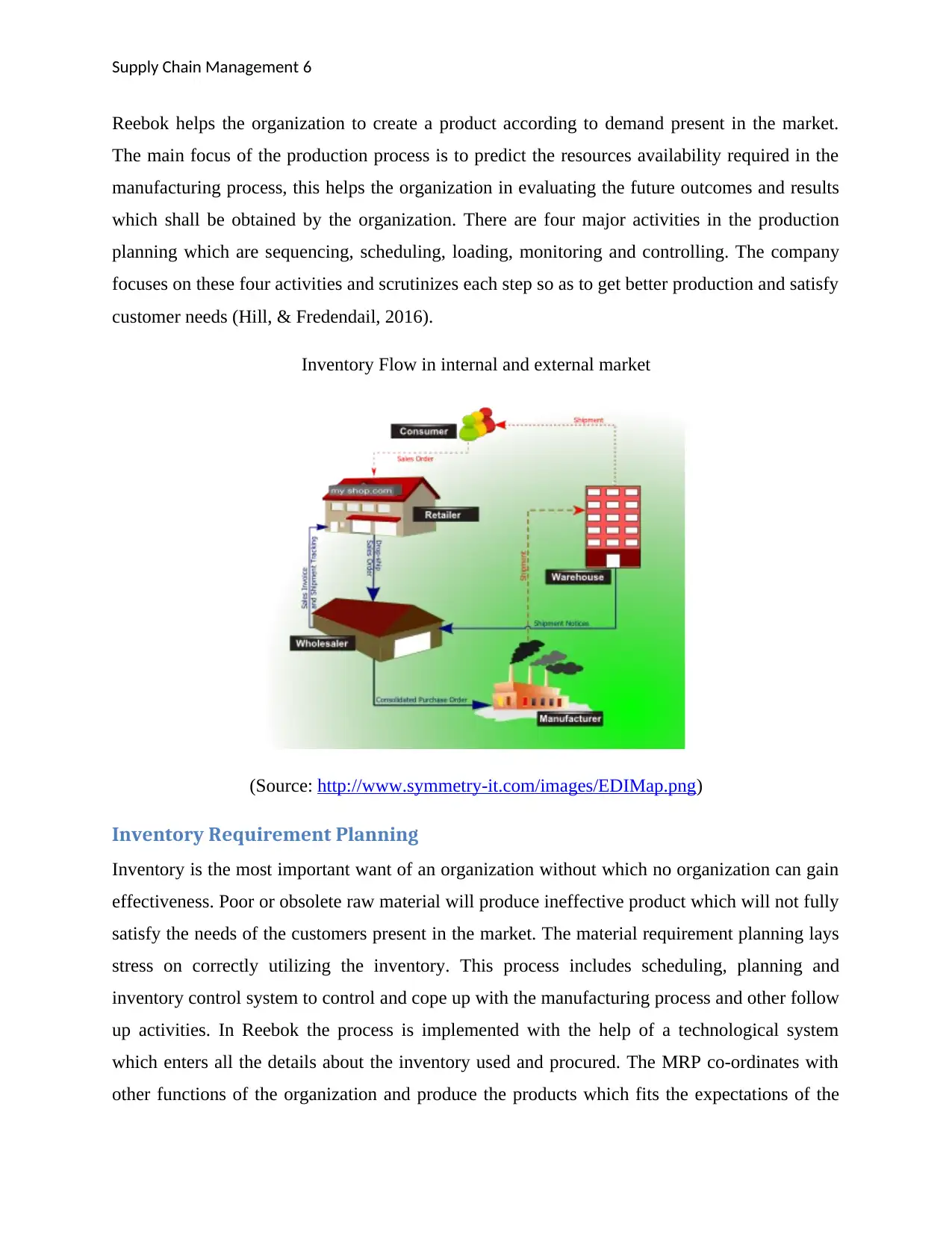
Supply Chain Management 6
Reebok helps the organization to create a product according to demand present in the market.
The main focus of the production process is to predict the resources availability required in the
manufacturing process, this helps the organization in evaluating the future outcomes and results
which shall be obtained by the organization. There are four major activities in the production
planning which are sequencing, scheduling, loading, monitoring and controlling. The company
focuses on these four activities and scrutinizes each step so as to get better production and satisfy
customer needs (Hill, & Fredendail, 2016).
Inventory Flow in internal and external market
(Source: http://www.symmetry-it.com/images/EDIMap.png)
Inventory Requirement Planning
Inventory is the most important want of an organization without which no organization can gain
effectiveness. Poor or obsolete raw material will produce ineffective product which will not fully
satisfy the needs of the customers present in the market. The material requirement planning lays
stress on correctly utilizing the inventory. This process includes scheduling, planning and
inventory control system to control and cope up with the manufacturing process and other follow
up activities. In Reebok the process is implemented with the help of a technological system
which enters all the details about the inventory used and procured. The MRP co-ordinates with
other functions of the organization and produce the products which fits the expectations of the
Reebok helps the organization to create a product according to demand present in the market.
The main focus of the production process is to predict the resources availability required in the
manufacturing process, this helps the organization in evaluating the future outcomes and results
which shall be obtained by the organization. There are four major activities in the production
planning which are sequencing, scheduling, loading, monitoring and controlling. The company
focuses on these four activities and scrutinizes each step so as to get better production and satisfy
customer needs (Hill, & Fredendail, 2016).
Inventory Flow in internal and external market
(Source: http://www.symmetry-it.com/images/EDIMap.png)
Inventory Requirement Planning
Inventory is the most important want of an organization without which no organization can gain
effectiveness. Poor or obsolete raw material will produce ineffective product which will not fully
satisfy the needs of the customers present in the market. The material requirement planning lays
stress on correctly utilizing the inventory. This process includes scheduling, planning and
inventory control system to control and cope up with the manufacturing process and other follow
up activities. In Reebok the process is implemented with the help of a technological system
which enters all the details about the inventory used and procured. The MRP co-ordinates with
other functions of the organization and produce the products which fits the expectations of the
Paraphrase This Document
Need a fresh take? Get an instant paraphrase of this document with our AI Paraphraser
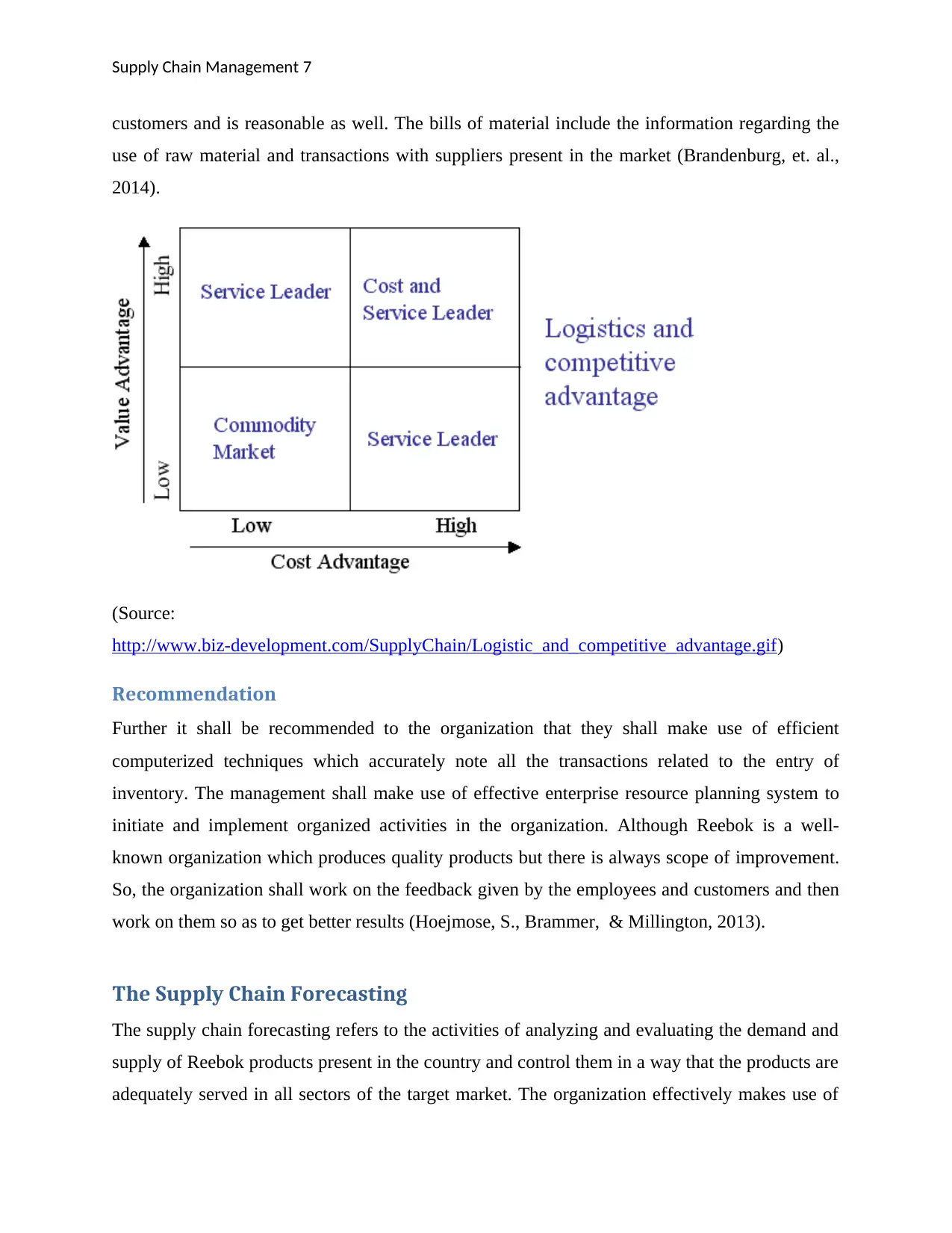
Supply Chain Management 7
customers and is reasonable as well. The bills of material include the information regarding the
use of raw material and transactions with suppliers present in the market (Brandenburg, et. al.,
2014).
(Source:
http://www.biz-development.com/SupplyChain/Logistic_and_competitive_advantage.gif)
Recommendation
Further it shall be recommended to the organization that they shall make use of efficient
computerized techniques which accurately note all the transactions related to the entry of
inventory. The management shall make use of effective enterprise resource planning system to
initiate and implement organized activities in the organization. Although Reebok is a well-
known organization which produces quality products but there is always scope of improvement.
So, the organization shall work on the feedback given by the employees and customers and then
work on them so as to get better results (Hoejmose, S., Brammer, & Millington, 2013).
The Supply Chain Forecasting
The supply chain forecasting refers to the activities of analyzing and evaluating the demand and
supply of Reebok products present in the country and control them in a way that the products are
adequately served in all sectors of the target market. The organization effectively makes use of
customers and is reasonable as well. The bills of material include the information regarding the
use of raw material and transactions with suppliers present in the market (Brandenburg, et. al.,
2014).
(Source:
http://www.biz-development.com/SupplyChain/Logistic_and_competitive_advantage.gif)
Recommendation
Further it shall be recommended to the organization that they shall make use of efficient
computerized techniques which accurately note all the transactions related to the entry of
inventory. The management shall make use of effective enterprise resource planning system to
initiate and implement organized activities in the organization. Although Reebok is a well-
known organization which produces quality products but there is always scope of improvement.
So, the organization shall work on the feedback given by the employees and customers and then
work on them so as to get better results (Hoejmose, S., Brammer, & Millington, 2013).
The Supply Chain Forecasting
The supply chain forecasting refers to the activities of analyzing and evaluating the demand and
supply of Reebok products present in the country and control them in a way that the products are
adequately served in all sectors of the target market. The organization effectively makes use of
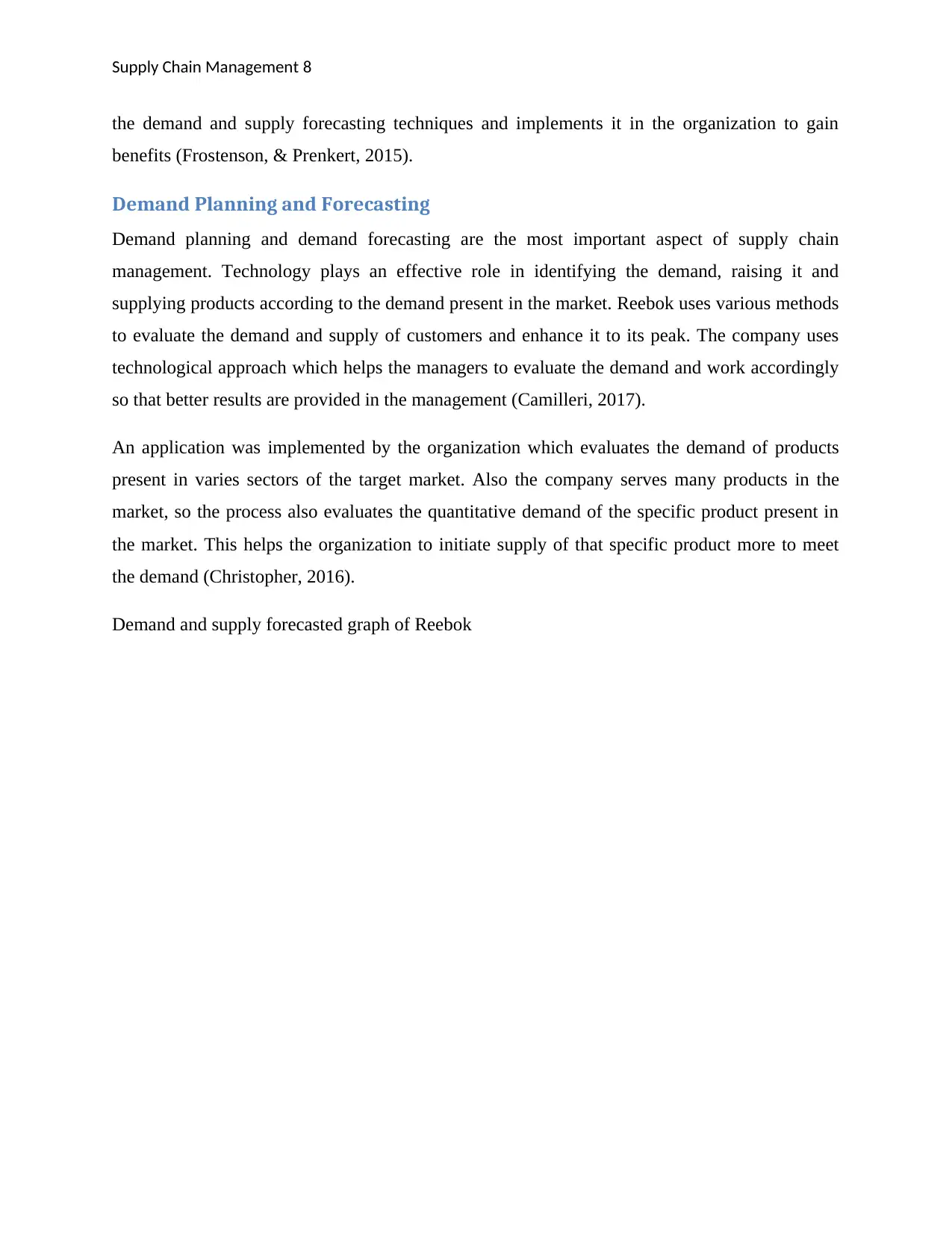
Supply Chain Management 8
the demand and supply forecasting techniques and implements it in the organization to gain
benefits (Frostenson, & Prenkert, 2015).
Demand Planning and Forecasting
Demand planning and demand forecasting are the most important aspect of supply chain
management. Technology plays an effective role in identifying the demand, raising it and
supplying products according to the demand present in the market. Reebok uses various methods
to evaluate the demand and supply of customers and enhance it to its peak. The company uses
technological approach which helps the managers to evaluate the demand and work accordingly
so that better results are provided in the management (Camilleri, 2017).
An application was implemented by the organization which evaluates the demand of products
present in varies sectors of the target market. Also the company serves many products in the
market, so the process also evaluates the quantitative demand of the specific product present in
the market. This helps the organization to initiate supply of that specific product more to meet
the demand (Christopher, 2016).
Demand and supply forecasted graph of Reebok
the demand and supply forecasting techniques and implements it in the organization to gain
benefits (Frostenson, & Prenkert, 2015).
Demand Planning and Forecasting
Demand planning and demand forecasting are the most important aspect of supply chain
management. Technology plays an effective role in identifying the demand, raising it and
supplying products according to the demand present in the market. Reebok uses various methods
to evaluate the demand and supply of customers and enhance it to its peak. The company uses
technological approach which helps the managers to evaluate the demand and work accordingly
so that better results are provided in the management (Camilleri, 2017).
An application was implemented by the organization which evaluates the demand of products
present in varies sectors of the target market. Also the company serves many products in the
market, so the process also evaluates the quantitative demand of the specific product present in
the market. This helps the organization to initiate supply of that specific product more to meet
the demand (Christopher, 2016).
Demand and supply forecasted graph of Reebok
⊘ This is a preview!⊘
Do you want full access?
Subscribe today to unlock all pages.

Trusted by 1+ million students worldwide
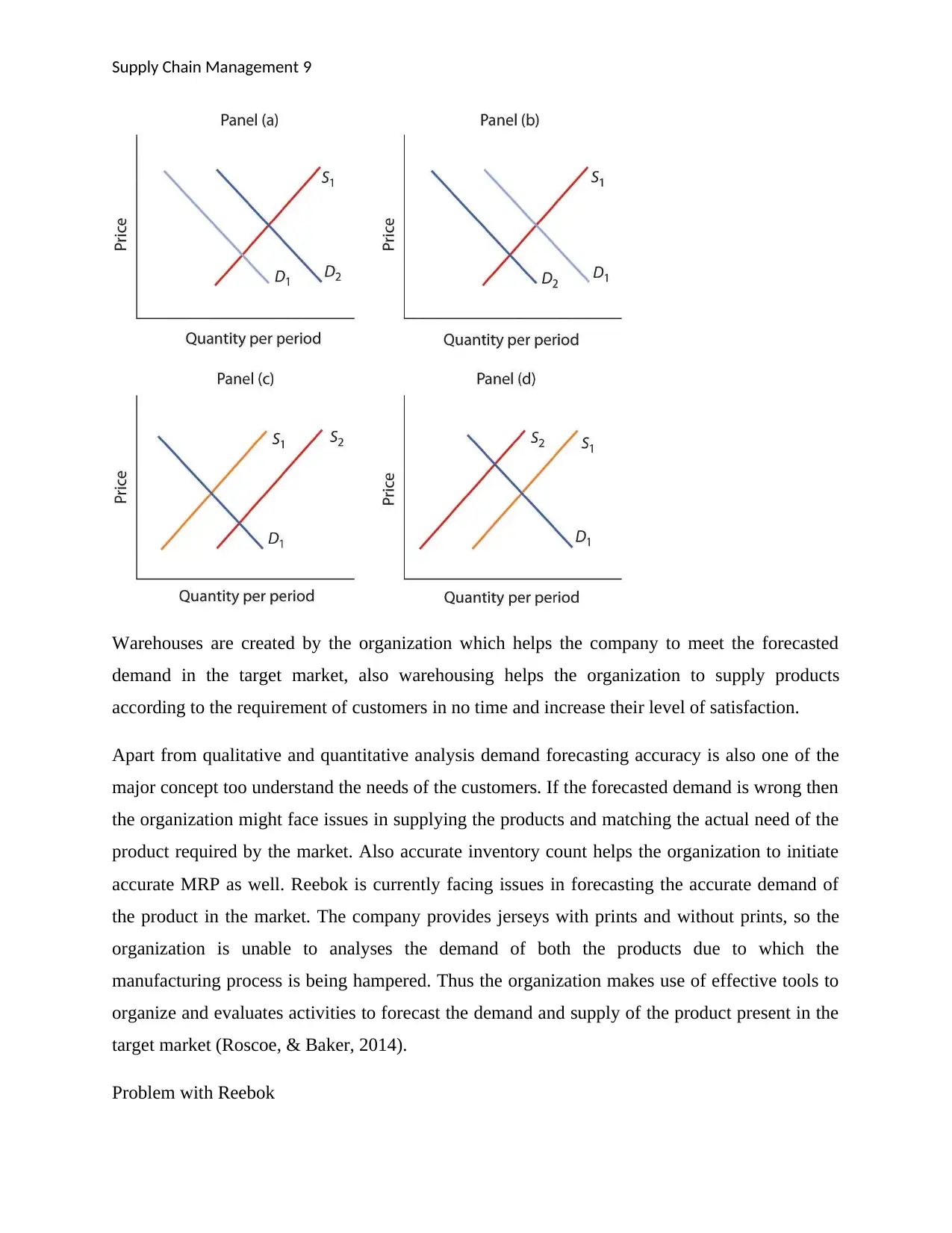
Supply Chain Management 9
Warehouses are created by the organization which helps the company to meet the forecasted
demand in the target market, also warehousing helps the organization to supply products
according to the requirement of customers in no time and increase their level of satisfaction.
Apart from qualitative and quantitative analysis demand forecasting accuracy is also one of the
major concept too understand the needs of the customers. If the forecasted demand is wrong then
the organization might face issues in supplying the products and matching the actual need of the
product required by the market. Also accurate inventory count helps the organization to initiate
accurate MRP as well. Reebok is currently facing issues in forecasting the accurate demand of
the product in the market. The company provides jerseys with prints and without prints, so the
organization is unable to analyses the demand of both the products due to which the
manufacturing process is being hampered. Thus the organization makes use of effective tools to
organize and evaluates activities to forecast the demand and supply of the product present in the
target market (Roscoe, & Baker, 2014).
Problem with Reebok
Warehouses are created by the organization which helps the company to meet the forecasted
demand in the target market, also warehousing helps the organization to supply products
according to the requirement of customers in no time and increase their level of satisfaction.
Apart from qualitative and quantitative analysis demand forecasting accuracy is also one of the
major concept too understand the needs of the customers. If the forecasted demand is wrong then
the organization might face issues in supplying the products and matching the actual need of the
product required by the market. Also accurate inventory count helps the organization to initiate
accurate MRP as well. Reebok is currently facing issues in forecasting the accurate demand of
the product in the market. The company provides jerseys with prints and without prints, so the
organization is unable to analyses the demand of both the products due to which the
manufacturing process is being hampered. Thus the organization makes use of effective tools to
organize and evaluates activities to forecast the demand and supply of the product present in the
target market (Roscoe, & Baker, 2014).
Problem with Reebok
Paraphrase This Document
Need a fresh take? Get an instant paraphrase of this document with our AI Paraphraser
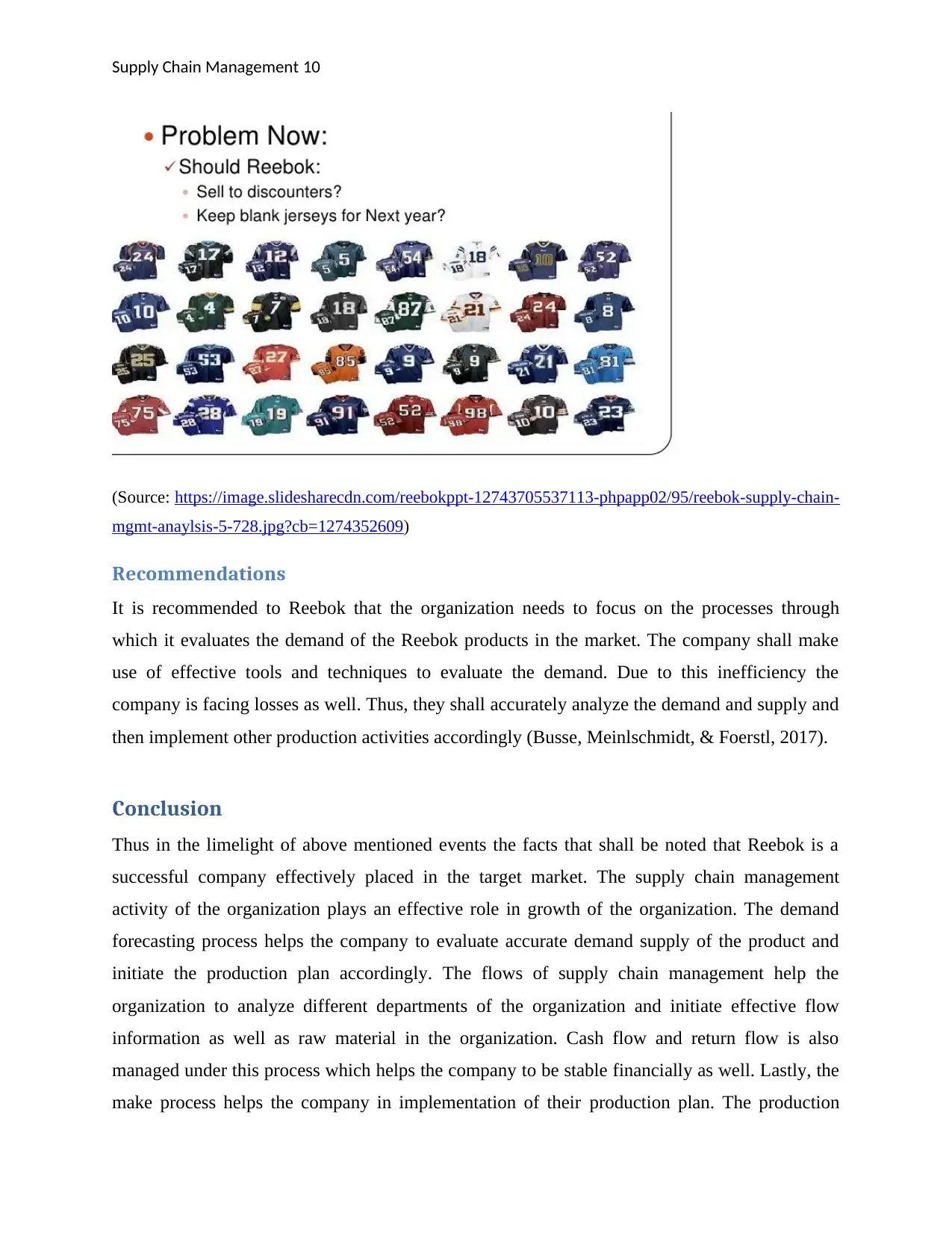
Supply Chain Management 10
(Source: https://image.slidesharecdn.com/reebokppt-12743705537113-phpapp02/95/reebok-supply-chain-
mgmt-anaylsis-5-728.jpg?cb=1274352609)
Recommendations
It is recommended to Reebok that the organization needs to focus on the processes through
which it evaluates the demand of the Reebok products in the market. The company shall make
use of effective tools and techniques to evaluate the demand. Due to this inefficiency the
company is facing losses as well. Thus, they shall accurately analyze the demand and supply and
then implement other production activities accordingly (Busse, Meinlschmidt, & Foerstl, 2017).
Conclusion
Thus in the limelight of above mentioned events the facts that shall be noted that Reebok is a
successful company effectively placed in the target market. The supply chain management
activity of the organization plays an effective role in growth of the organization. The demand
forecasting process helps the company to evaluate accurate demand supply of the product and
initiate the production plan accordingly. The flows of supply chain management help the
organization to analyze different departments of the organization and initiate effective flow
information as well as raw material in the organization. Cash flow and return flow is also
managed under this process which helps the company to be stable financially as well. Lastly, the
make process helps the company in implementation of their production plan. The production
(Source: https://image.slidesharecdn.com/reebokppt-12743705537113-phpapp02/95/reebok-supply-chain-
mgmt-anaylsis-5-728.jpg?cb=1274352609)
Recommendations
It is recommended to Reebok that the organization needs to focus on the processes through
which it evaluates the demand of the Reebok products in the market. The company shall make
use of effective tools and techniques to evaluate the demand. Due to this inefficiency the
company is facing losses as well. Thus, they shall accurately analyze the demand and supply and
then implement other production activities accordingly (Busse, Meinlschmidt, & Foerstl, 2017).
Conclusion
Thus in the limelight of above mentioned events the facts that shall be noted that Reebok is a
successful company effectively placed in the target market. The supply chain management
activity of the organization plays an effective role in growth of the organization. The demand
forecasting process helps the company to evaluate accurate demand supply of the product and
initiate the production plan accordingly. The flows of supply chain management help the
organization to analyze different departments of the organization and initiate effective flow
information as well as raw material in the organization. Cash flow and return flow is also
managed under this process which helps the company to be stable financially as well. Lastly, the
make process helps the company in implementation of their production plan. The production
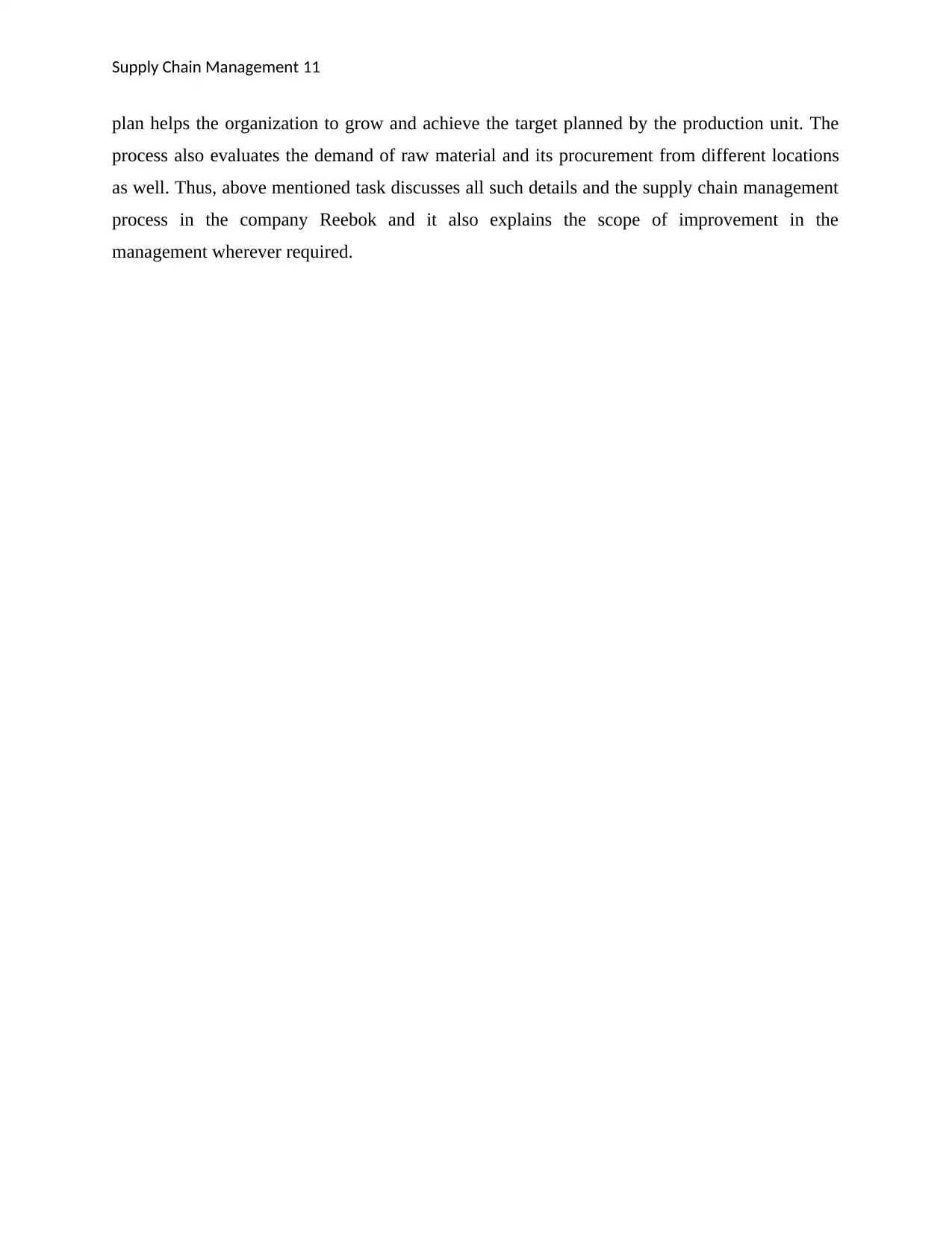
Supply Chain Management 11
plan helps the organization to grow and achieve the target planned by the production unit. The
process also evaluates the demand of raw material and its procurement from different locations
as well. Thus, above mentioned task discusses all such details and the supply chain management
process in the company Reebok and it also explains the scope of improvement in the
management wherever required.
plan helps the organization to grow and achieve the target planned by the production unit. The
process also evaluates the demand of raw material and its procurement from different locations
as well. Thus, above mentioned task discusses all such details and the supply chain management
process in the company Reebok and it also explains the scope of improvement in the
management wherever required.
⊘ This is a preview!⊘
Do you want full access?
Subscribe today to unlock all pages.

Trusted by 1+ million students worldwide
1 out of 14
Related Documents
Your All-in-One AI-Powered Toolkit for Academic Success.
+13062052269
info@desklib.com
Available 24*7 on WhatsApp / Email
![[object Object]](/_next/static/media/star-bottom.7253800d.svg)
Unlock your academic potential
Copyright © 2020–2025 A2Z Services. All Rights Reserved. Developed and managed by ZUCOL.





